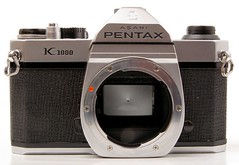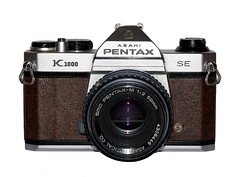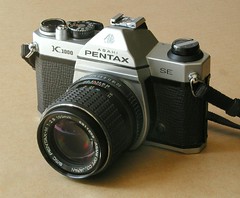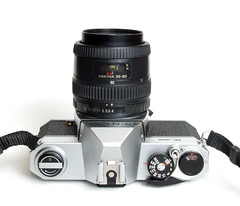Difference between revisions of "Pentax K1000"
(→Overview) |
(→Links: period ad scan, reformat manual link) |
||
| (46 intermediate revisions by 12 users not shown) | |||
| Line 1: | Line 1: | ||
| − | {| | + | {{Flickr_image |
| − | + | |image_source= http://www.flickr.com/photos/martintaylor/47936863/in/pool-camerawiki | |
| − | | | + | |image= http://farm1.static.flickr.com/28/47936863_968b681121_m.jpg |
| − | || '' | + | |image_align= right |
| + | |image_text= | ||
| + | |image_by= Martin Taylor | ||
| + | |image_rights= nc | ||
| + | }} | ||
| + | |||
| + | The '''Asahi Pentax K1000''' was introduced in 1976 as part of the line of cameras such as the [[Pentax KX|Kx]], [[Pentax K2|K2]], and [[Pentax KM|KM]] which heralded change from M42 to [[K_mount_lenses|K-mount]]. The '''K1000''' was the most affordable camera of the line, aimed at the amateur photographer . It survived much longer than originally intended, with production running until 1997, and due to its ruggedness, and simplicity it became the archetypal ''students' camera''. More than 3 million copies were sold, and production was moved from Japan to Hong Kong (1978) to China (1990). | ||
| + | |||
| + | ==Description== | ||
| + | |||
| + | The K1000, is the simplest member of Asahi Optical's Pentax K-series 35mm SLRs. Introduced a year late than the Pentax K2, KM, and KX (1975), and at the same time as the K2-DMD (1976). All have the same basic body design, a direct [[Pentax Spotmatic|Spotmatic]] derivative, but with differing feature levels, electronics, and controls. The K1000 was the KM without the self-timer, depth of field pre-view and some other features removed to save cost. | ||
| + | |||
| + | {|class=floatright | ||
| + | {{Flickr_image | ||
| + | |image_source= https://www.flickr.com/photos/127540935@N08/51640410144/in/pool-camerawiki | ||
| + | |image= https://live.staticflickr.com/65535/51640410144_ae9b2b41b2_n.jpg | ||
| + | |image_align= right | ||
| + | |image_text= Pentax K-1000 early model | ||
| + | |image_by=yashicasailorboy | ||
| + | |image_rights= with permission | ||
| + | }} | ||
|} | |} | ||
| − | == | + | Among the differences with the [[Spotmatic]] SP F are a plastic band on the front of the pentaprism and a modern synthetic leatherette. The wind lever has a plastic-coating, and no self-timer is present. There is no hot shoe switch or film reminder around the rewind knob, just a blank plate. The lens mount was changed to the K-mount, and a the battery is a LR44 alkaline or silver oxide (S76, SR44 or 357) 1.5v battery, extremely common among 70's SLR's and cheap into the present day. The battery is placed in a compartment on the bottom of the camera. |
| + | Ever-ready cases for the Spotmatics interchange with the K1000 and vice versa, as the outward dimensions of the body are the same and the location of the tripod socket is unchanged. | ||
| + | |||
| + | <!---It can accept all the K-mount lenses made by [[Pentax]] and licensees such as [[Ricoh]] and [[Cosina]].--> | ||
| + | |||
| + | Over the life of the K-1000 small changes can be observed, such as the change of the Asahi name and AoCo logo to PENTAX. | ||
| + | |||
| + | ===Shutter=== | ||
| + | |||
| + | The shutter is mechanical, horizontal focal plane type made of cloth. It is identical to the Spotmatic shutter. Notably, this shutter, like the [[Nikon F2]], permits the shutter speed dial to be turned 360 degrees, with no stop between 1/1000th and B. | ||
| + | |||
| + | The shutter is quite standard for a 60's SLR, but probably a little dated in the 1970's for being a mechanical, horizontally-traveling cloth shutter. <!-- Certainly by the 1990's this shutter would have been archaic.--> X-sync is 1/60th, top speed is 1/1000th, bottom mechanical speed is one second, and additionally there is a bulb mode. Flash sync is X only, by either PC socket or hot shoe. | ||
| + | |||
| + | ===Viewfinder=== | ||
| + | |||
| + | The viewfinder is nearly identical to the [[Spotmatic]] with 0,88x magnification and 92% image coverage. | ||
| + | It has a matte area surrounding a microprism spot <!--this was something of a fad among Japanese SLR's of the 1960's -->. | ||
| + | On the right side the lightmeter is shown -- when the exposure is correct the needle will be centered. | ||
| + | <!--This is a fairly large viewfinder, but none too bright. --> | ||
| + | |||
| + | <!-- | ||
| + | ===Lens Mount=== | ||
| + | |||
| + | This camera was one of the first to have the K-mount. This is a bayonet mount designed to preserve certain characteristics of the M42 mount, including flange distance. M42 lenses can be adapted to K-mount very easily. However, like the Pentax M42 mount before it, it adds an aperture linkage to allow the camera to meter with the aperture wide open. --> | ||
| + | |||
| + | <!-- The only way to preview the depth-of-field is to release the lens and gingerly twist it as if to take it off--this is not the only camera or only lens mount where this is the case. Without pressure on the linkage, the aperture will close, though one must be careful not to disturb the focus and aperture while doing so. --> | ||
| + | |||
| + | ===Variant=== | ||
| + | |||
| + | The '''K1000 SE''' is almost identical, the only difference being the addition of [[split prism|split-prism rangefinder]] and [[microprism]] ring focusing aids to the focusing screen. Initial versions also had a brownish coloured leatherette, while later SE's were the normal black. | ||
| + | |||
| + | ===Country of manufacture=== | ||
| + | |||
| + | During its long production run, the K1000 was manufactured firstly in Japan, then Hong Kong, and finally China, with some specification changes along the way. | ||
| − | + | Japan: | |
| − | + | 1. says "Asahi" on the pentaprism cover, and "Asahi Opt Co Japan" on the back to plate under the winder | |
| − | + | 2. has a "fill plug" on the left side of the prism, where the battery test switch is found from the KX | |
| − | + | 3. all metal top and bottom plates | |
| + | 4. metal shutter speed selector. | ||
| + | |||
| + | Hong Kong (1978-1990): | ||
| + | |||
| + | 1. has a small screw where the KX's battery test button was | ||
| + | |||
| + | 2. does not say Japan on the back of the top plate | ||
| + | |||
| + | China (1990-1997): | ||
| + | |||
| + | 1. plastic top and bottom plates | ||
| + | |||
| + | 2. does not say Asahi on the prism | ||
| + | |||
| + | 3. does not have a bump or a screw where the KX's battery test was | ||
| + | |||
| + | 4. shutter speed dial does not have a silver edge, and is made of black plastic. | ||
| + | |||
| + | <!--In China, the assembly line went to five cooperating camera factories in the Sichuan province, which produced the [[Pearl River S-201]] SLR camera (a [[Nikon F]] inspired [[Minolta SR-2|Minolta SR]] clone). For the domestic Chinese market a K1000 derivative was sold as the Mingca/Pearl River S-207 or [[Mingca_MC_K1000|Mingca MC K1000]].<ref>[http://www.novacon.com.br/odditycameras/chinese%20006.htm]Novacon Oddity Cameras page </ref> --> | ||
| + | |||
| + | ==Specifications== | ||
| + | * Type: [[SLR]] body | ||
| + | * Manufacturer: [[Asahi]] Optical Co. | ||
| + | * Year of launch: 1976 | ||
| + | * Films: [[35mm]], speeds up to 6400 [[ASA]] | ||
| + | * Viewfinder: [[pentaprism]] eye-level viewfinder | ||
| + | * Lens Mount: [[K_mount_lenses| Pentax K Bayonet]] | ||
| + | * Shutter: [[Focal plane shutter]], speeds 1 - 1/1000 second, [[flash sync]] 1/60 second | ||
| + | * Metering: [[CdS]] [[TTL]] average metering ([[Open-aperture metering]] match-needle metering system) [[Exposure value|EV]] 1.7 ~ 18 (ISO 100) [[ASA]] range 8-6400 | ||
| + | * Self timer: None | ||
| + | * Flash shoe: X-synchronized for electronic flash | ||
| + | * Battery 1 SR44 (AG13) or equivalent | ||
| + | {{br}} | ||
| + | |||
| + | ==Conclusion== | ||
| + | |||
| + | Despite its great popularity, [[Pentax]] finally ceased production of the K1000 after more than 20 years in 1997, thus ending a more-than 30-year design continuity going back to the Spotmatic SP, in which time the shutter and viewfinder essentially did not change. | ||
| + | |||
| + | If nothing else, the K1000 demonstrates the value of simplicity. An SLR could hardly be more basic in the 1970's. It did not have the self-timer, stop-down lever and various bells and whistles that would make for a "full-featured" SLR in that era, but it was affordable, pleasant in the hands and easy enough to use, and owing to its simplicity it gained a huge market in being the bulk camera bought by universities and even high schools for photography classes. It has been the first camera of countless amateur and professional photographers into the present day, and there are those who swear by it as their main camera. <!-- Like the [[Canon AE-1|AE-1]] and the [[Argus C3|C3]], it has become one of the classic budget cameras. --> | ||
| + | |||
| + | {{Flickr_image | ||
| + | |image_source= http://www.flickr.com/photos/wolf-t/7329995426/in/pool-camerawiki/ | ||
| + | |image= http://farm8.staticflickr.com/7211/7329995426_32774c0307_m.jpg | ||
| + | |image_align= left | ||
| + | |image_text= K1000 SE with brown leatherette | ||
| + | |image_by= wolf4max | ||
| + | |image_rights= non-commercial | ||
| + | }} | ||
| + | {{Flickr_image | ||
| + | |image_source= http://www.flickr.com/photos/loloboho/2425504149/in/pool-camerawiki/ | ||
| + | |image= http://farm3.staticflickr.com/2298/2425504149_cd5338b33c_m.jpg | ||
| + | |image_align= left | ||
| + | |image_text= K1000 SE with black leatherette | ||
| + | |image_by= loloboho | ||
| + | |image_rights= wp | ||
| + | }} | ||
| + | {{br}} | ||
| + | |||
| + | {{Flickr_image | ||
| + | |image_source= http://www.flickr.com/photos/s-demir/4547016845/in/pool-camerawiki/ | ||
| + | |image= http://farm5.staticflickr.com/4034/4547016845_d35a136881_m.jpg | ||
| + | |image_align= left | ||
| + | |image_text= late model | ||
| + | |image_by= Süleyman Demir | ||
| + | |image_rights= wp | ||
| + | }} | ||
| + | {{Flickr_image | ||
| + | |image_source= http://www.flickr.com/photos/s-demir/4547653688/in/pool-camerawiki/ | ||
| + | |image= http://farm5.staticflickr.com/4057/4547653688_22847c0562_m.jpg | ||
| + | |image_align= | ||
| + | |image_text= top view | ||
| + | |image_by= Süleyman Demir | ||
| + | |image_rights= wp | ||
| + | }} | ||
== Links == | == Links == | ||
| − | + | * [http://www.butkus.org/chinon/pentax/pentax_k1000/pentax_k1000.htm K1000 manual] at Mike Butkus's [http://www.butkus.org/chinon/ OrphanCameras.com] | |
| + | * Early ad for the K1000 [https://www.flickr.com/photos/camerawiki/52762200019/in/pool-camerawiki/ in November, 1976, ''Popular Photography''] (Vol. 79, No. 5; page 81) | ||
* [http://www.photoethnography.com/ClassicCameras/index-frameset.html?AsahiPentaxK1000.html~mainFrame Photoethography review of the K1000] | * [http://www.photoethnography.com/ClassicCameras/index-frameset.html?AsahiPentaxK1000.html~mainFrame Photoethography review of the K1000] | ||
* [http://www.mattdentonphoto.com/cameras/pentax_k1000.html Matt Denton's K1000] | * [http://www.mattdentonphoto.com/cameras/pentax_k1000.html Matt Denton's K1000] | ||
| − | * [http:// | + | * [http://kmp.pentaxians.eu/bodies/film_k/k1000/ Pentax K1000] at [http://kmp.pentaxians.eu/ Bojidar Dimitrov's Pentax K-Mount Page] |
| − | |||
* [http://www.ne.jp/asahi/japan/manual-camera/k10001.htm Manual Cameras: K1000] | * [http://www.ne.jp/asahi/japan/manual-camera/k10001.htm Manual Cameras: K1000] | ||
* [http://www.theothermartintaylor.com/moveabletype/archives/cameras/000217.html The Other Martin Taylor: In praise of the humble K1000] | * [http://www.theothermartintaylor.com/moveabletype/archives/cameras/000217.html The Other Martin Taylor: In praise of the humble K1000] | ||
* [http://en.wikipedia.org/wiki/Pentax_K1000 Wikipedia K1000 entry] | * [http://en.wikipedia.org/wiki/Pentax_K1000 Wikipedia K1000 entry] | ||
| − | * [http://www.collection-appareils.fr/ | + | * [http://www.collection-appareils.fr/x/html/page_standard.php?id_appareil=11127 K 1000 Post] on [http://www.collection-appareils.fr/general/html/francais.php www.collection-appareils.fr] by Sylvain Halgand (in French) |
| − | |||
{{Pentax K mount}} | {{Pentax K mount}} | ||
| Line 30: | Line 156: | ||
[[Category: K mount]] | [[Category: K mount]] | ||
[[Category: Japanese 35mm SLR]] | [[Category: Japanese 35mm SLR]] | ||
| − | [[Category: Pentax]] | + | [[Category: Pentax|K1000]] |
| − | [[Category: | + | [[Category: K|K1000 Pentax]] |
| − | [[Category: | + | [[Category: 1976]] |
Latest revision as of 17:35, 21 March 2023

|
| image by Martin Taylor (Image rights) |
The Asahi Pentax K1000 was introduced in 1976 as part of the line of cameras such as the Kx, K2, and KM which heralded change from M42 to K-mount. The K1000 was the most affordable camera of the line, aimed at the amateur photographer . It survived much longer than originally intended, with production running until 1997, and due to its ruggedness, and simplicity it became the archetypal students' camera. More than 3 million copies were sold, and production was moved from Japan to Hong Kong (1978) to China (1990).
Contents
Description
The K1000, is the simplest member of Asahi Optical's Pentax K-series 35mm SLRs. Introduced a year late than the Pentax K2, KM, and KX (1975), and at the same time as the K2-DMD (1976). All have the same basic body design, a direct Spotmatic derivative, but with differing feature levels, electronics, and controls. The K1000 was the KM without the self-timer, depth of field pre-view and some other features removed to save cost.

|
| Pentax K-1000 early model image by yashicasailorboy (Image rights) |
Among the differences with the Spotmatic SP F are a plastic band on the front of the pentaprism and a modern synthetic leatherette. The wind lever has a plastic-coating, and no self-timer is present. There is no hot shoe switch or film reminder around the rewind knob, just a blank plate. The lens mount was changed to the K-mount, and a the battery is a LR44 alkaline or silver oxide (S76, SR44 or 357) 1.5v battery, extremely common among 70's SLR's and cheap into the present day. The battery is placed in a compartment on the bottom of the camera. Ever-ready cases for the Spotmatics interchange with the K1000 and vice versa, as the outward dimensions of the body are the same and the location of the tripod socket is unchanged.
Over the life of the K-1000 small changes can be observed, such as the change of the Asahi name and AoCo logo to PENTAX.
Shutter
The shutter is mechanical, horizontal focal plane type made of cloth. It is identical to the Spotmatic shutter. Notably, this shutter, like the Nikon F2, permits the shutter speed dial to be turned 360 degrees, with no stop between 1/1000th and B.
The shutter is quite standard for a 60's SLR, but probably a little dated in the 1970's for being a mechanical, horizontally-traveling cloth shutter. X-sync is 1/60th, top speed is 1/1000th, bottom mechanical speed is one second, and additionally there is a bulb mode. Flash sync is X only, by either PC socket or hot shoe.
Viewfinder
The viewfinder is nearly identical to the Spotmatic with 0,88x magnification and 92% image coverage. It has a matte area surrounding a microprism spot . On the right side the lightmeter is shown -- when the exposure is correct the needle will be centered.
Variant
The K1000 SE is almost identical, the only difference being the addition of split-prism rangefinder and microprism ring focusing aids to the focusing screen. Initial versions also had a brownish coloured leatherette, while later SE's were the normal black.
Country of manufacture
During its long production run, the K1000 was manufactured firstly in Japan, then Hong Kong, and finally China, with some specification changes along the way.
Japan:
1. says "Asahi" on the pentaprism cover, and "Asahi Opt Co Japan" on the back to plate under the winder
2. has a "fill plug" on the left side of the prism, where the battery test switch is found from the KX
3. all metal top and bottom plates
4. metal shutter speed selector.
Hong Kong (1978-1990):
1. has a small screw where the KX's battery test button was
2. does not say Japan on the back of the top plate
China (1990-1997):
1. plastic top and bottom plates
2. does not say Asahi on the prism
3. does not have a bump or a screw where the KX's battery test was
4. shutter speed dial does not have a silver edge, and is made of black plastic.
Specifications
- Type: SLR body
- Manufacturer: Asahi Optical Co.
- Year of launch: 1976
- Films: 35mm, speeds up to 6400 ASA
- Viewfinder: pentaprism eye-level viewfinder
- Lens Mount: Pentax K Bayonet
- Shutter: Focal plane shutter, speeds 1 - 1/1000 second, flash sync 1/60 second
- Metering: CdS TTL average metering (Open-aperture metering match-needle metering system) EV 1.7 ~ 18 (ISO 100) ASA range 8-6400
- Self timer: None
- Flash shoe: X-synchronized for electronic flash
- Battery 1 SR44 (AG13) or equivalent
Conclusion
Despite its great popularity, Pentax finally ceased production of the K1000 after more than 20 years in 1997, thus ending a more-than 30-year design continuity going back to the Spotmatic SP, in which time the shutter and viewfinder essentially did not change.
If nothing else, the K1000 demonstrates the value of simplicity. An SLR could hardly be more basic in the 1970's. It did not have the self-timer, stop-down lever and various bells and whistles that would make for a "full-featured" SLR in that era, but it was affordable, pleasant in the hands and easy enough to use, and owing to its simplicity it gained a huge market in being the bulk camera bought by universities and even high schools for photography classes. It has been the first camera of countless amateur and professional photographers into the present day, and there are those who swear by it as their main camera.

|
| K1000 SE with brown leatherette image by wolf4max (Image rights) |

|
| K1000 SE with black leatherette image by loloboho (Image rights) |

|
| late model image by Süleyman Demir (Image rights) |

|
| top view image by Süleyman Demir (Image rights) |
Links
- K1000 manual at Mike Butkus's OrphanCameras.com
- Early ad for the K1000 in November, 1976, Popular Photography (Vol. 79, No. 5; page 81)
- Photoethography review of the K1000
- Matt Denton's K1000
- Pentax K1000 at Bojidar Dimitrov's Pentax K-Mount Page
- Manual Cameras: K1000
- The Other Martin Taylor: In praise of the humble K1000
- Wikipedia K1000 entry
- K 1000 Post on www.collection-appareils.fr by Sylvain Halgand (in French)
| Pentax K mount SLR Cameras |
|---|
| K2 | KX | KM | K1000 | MX | ME | ME Super | ME-F | MV | MV1 | MG | LX | Super-A | Program-A | A3 | P30| P30n/P3n/P30t | P50 | SFX/SF1 | SF7/SF10 | SFXn/SF1n | Z-1/PZ-1 | Z-10/PZ-10 | Z-20/PZ-20 | Z-50p | Z-5 | Z-5p | Z-70/PZ-70 | Z-1p/PZ-1p | MZ-5/ZX-5 | MZ-3/ZX-3 | MZ-5N/ZX-5N | MZ-7/ZX-7 | MZ-6/ZX-L | MZ-S | MZ-10/ZX-10 | MZ-50/ZX-50 | MZ-30/ZX-30 | MZ-60/ZX-60 | Pentax *ist | MZ-M/ZX-M |